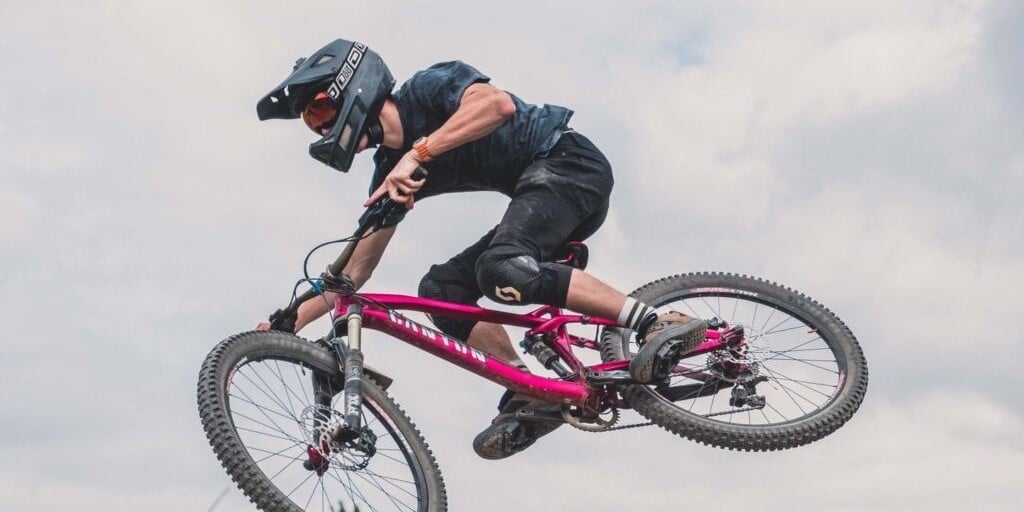Interested in learning more about bicycle motocross racing? Read on for a short overview of what it is and how it evolved in the US
What is BMX Racing? The Basics of Bicycle Motocross Racing
QUICK SUMMARY: Interested in learning more about bicycle motocross racing? Read on for a short overview of what the sport is, how it evolved in the US, and what you can do to get involved.

Table of Contents
Bicycle Motocross, or BMX, is a relatively recent sport that gained traction in the 1970s and 1980s. This type of biking requires a different style of bike than either a road bike or mountain bike. BMX bikes are designed to be lighter and faster to provide an advantage on off-road tracks. Read on to find out more about the sport, its history, and how to get involved according to regulations in the United States.
Defining BMX
The sport can be divided into two main categories: racing and freestyling. Racing is a competition based upon speed whereas freestyle is judged on difficulty, style, and originality. Here, we will focus specifically on BMX racing.
What to understand about racing
In the United States, USA BMX now serves as a regulating body for the sport at large. There may be some variance in how the sport works in other countries which won’t be explored here. At its core, BMX racing is designed to be the bicycle equivalent, and therefore more age-inclusive version, of motocross racing. Points are scored when you place in the race. The number of points earned depends upon your racing classification.
Sanctioned races take place around tracks with changing terrain and level of difficulty. A list of regulated tracks can be found through the USA BMX site and you can search for the track nearest you.
The weight of the bike and the material used in its manufacturing have a strong impact on its capabilities. To lighten the weight, a front brake is often left off. The rear brake must be available and in working order to meet safety regulations, even if the rider opts to rarely use it.
Features of a typical BMX racing bike include:
- Single gear
- 20” wheels
- Steel forks
- Platform pedals
- Rear brake
- Low, lightweight seat (hardly used)
- High, rigid handlebars
There are acceptable variations in weight and material. When you are considering what features your BMX bike needs, think about aspects such as ease of maintaining the bike and your current status in the sport. Some of the simpler designs may be more suitable for novices.
How did the sport develop?
The sport gained popularity due to kids modeling motorcycle racers they admired by racing bicycles in vacant lots. A documentary filmed in California used footage of this activity and the idea spread quickly across the country. The developing sport continued to gain popularity in the late 1970s and early 1980s as bike manufacturing practices improved.
With the growing interest in BMX, those passionate about the sport wanted to legitimize it and the first of several regulating bodies was formed. These organizations arranged races and made sure safe practices were followed. Rules for legitimate competitions were set by these groups, as were any penalties for not following regulations.
A mini timeline:
A Brief History of BMX Racing

late 1960s-early 1970s
It is difficult to pinpoint the exact moment in time, but it is widely believed that BMX got its start in the US in this time range.
1974
George E. Esser founded the National Bicycle League (NBL) to sanction organizations


1977
The American Bicycle Association (ABA) is formed to fill the gap in sanctioning the sport
1995
BMX takes place in the first X Games


2008
BMX racing became an Olympic sport
2011
ABA bought out NBL and formed USA BMX

What’s it like now?
Regulations for BMX racing continue to evolve with the sport. In the US, official BMX racing is mostly organized through USA BMX. There is a system that tracks your classification in the sport, updating your numbers as it becomes necessary. To compete in any sanctioned races, you need to fill out the appropriate membership forms.
Basics of competition
Regulated races are sprints involving up to eight riders. When more than eight racers are competing in the same classification, racers are grouped into heats. The winning racers from each heat will then compete in the main event.
Tracks often include hills and tight corners. The design of the track may vary in difficulty as long as safety standards are met. Safe practices are a priority.
The scoring system
In each competition, specific classifications are divided into races of up to eight riders. There are qualifying rounds for each racing category leading up to the main events. As you race, you can accumulate points for ranking purposes. Racers can gain points for the majority of the year. In 2020, the district point season is from January 1st to December 15th. When there are ties in any category, they can be broken by measuring how many times the rider finished first through fifth. If the tie still hasn’t broken using these measurements, the first place goes to the person with the earliest membership date. Points can also be scored at a national level and a state level. Your racing plates need to maintain updated information about your current classification.
Levels of competition
Four major factors are influencing where you will be placed in the competition: age, gender, skill, and wheel size. Skill level ranges from rookie to pro, each with associated age ranges. You can start learning at pretty much any age and there will be a classification in which you belong. The factors influencing your category are designed for even matches, making it more likely that races will be close and more exciting for the riders and their audience.
How do you get involved?
Here are steps to immerse yourself in BMX racing:
- Find your local track
- Sign up (trial memberships are available)
- Get classified based on age, gender, skill, and wheel size
- Check your racing number
- Get to your staging area
- Start slowly by familiarizing yourself with the track and observing other riders
- Work your way towards awards
- Get to know the big races
Although getting set up is easy, there will be a learning curve. Skills come from consistent practice.
Regulations
Like in any sport, BMX racing regulations are put in place to keep things running smoothly and safely. Familiarize yourself with any updates to stay on top of things.
Some highlights to keep in mind:
- Riders must keep riding numbers attached to their handlebars
- Current sanction numbers must be presented in the proper format
- Your bike must have a working braking system
- Your bike must meet maintenance standards
- Track safety is a priority
To best understand the sport, some terms need to be understood. Familiarize yourself with:
- Types of turns
- Types of hills
- Possible track components
For a more detailed account, visit the USA BMX website.
Safety and Gear
The big safety regulations involve full-body covering, offering a layer of protection everywhere. You will need:
- A full-face helmet
- Goggles
- Biking gloves
- Long-sleeved jersey
- Padded pants
- Flat soled shoes
The above list demonstrates best practices; there are acceptable variations. If you have questions about acceptable gear, ask the experts! A local bike shop is likely to have the information that you need.
FAQ
Who invented BMX racing?
Scot Breithaupt organized the first legitimate BMX race in 1970.
When was the first BMX bike invented?
The Schwinn Stingray came out in 1963.
Who is the fastest BMX racer in the world?
In 2019, Joris Daudet won the first day of the UCI BMX Supercross World Cup.
What was the inspiration for creating BMX racing?
BMX racing was created as a more accessible version of motocross racing.
Where is BMX most popular?
Austin, Texas is considered one of the best places to ride.
